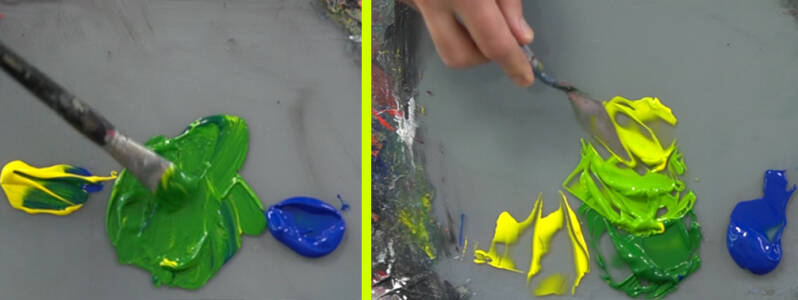I often get asked why acrylic paint dries so fast on the palette—and why it seems to last longer on mine.
One simple reason is that I typically use a bit more paint. When you put only a small amount on the palette, it dries up quickly.
I understand that it’s tempting to use less paint to avoid waste and manage costs. But, in my experience, using just a little more can actually be more economical and efficient.
Here’s why: when there’s enough paint on the palette, it not only dries slower, but it also reduces the need to remix colors constantly. This can be especially helpful in avoiding color shifts, which often happen when you remix and the colors dry differently. With a good amount of paint, you’ll spend less time adjusting colors, which helps avoid errors and lets you work more smoothly.
So, while it might seem counterintuitive, using a bit more paint can end up saving you time, effort, and, ultimately, paint.
But of course, the climate that you work in can make a big difference as well. In humid environments (like the Netherlands where I'm from) the paints will dry slightly slower. In hot and dry climates, the paint will dry way faster. So below are some general tips, I hope there are some useful ones for your specific situation.

Drying time on canvas / paper etc.
Acrylics dry very quickly on. The drying process consists of various stages, but generally, the paint is sufficiently dry after 10-15 minutes, making wet-on-wet techniques no longer feasible.
Please note: the actual drying time is much longer; a regular layer of acrylic paint will only be completely dry inside and out after one to two weeks. This is particularly important to remember if you plan to varnish your painting after it’s finished.
Prepare the surface you're painting on
Prime the canvas with one or more layers of gesso to create a barrier between the paint and the surface. This slows down the drying time, giving you better control over the paint.
Even on pre-primed canvases, adding an extra layer of gesso can make a big difference—I’ve tested it repeatedly. Canvases often come with a quick or diluted priming, and some even have grease stains. An additional layer of gesso not only improves the painting experience but also saves on paint, giving you more coverage.
Gesso is even more essential when working on paper, as paper absorbs moisture from the paint much faster. Applying a coat of gesso will help, and it’s recommended to dilute the gesso slightly with water for smoother application on paper.
Use a non-absorbent palette
Not all surfaces are ideal for a palette. For example, cardboard is highly absorbent, which causes paint to dry almost instantly. Better options include glass, plastic, ceramic, or tear-off palettes, as these materials are non-absorbent and help keep your paints workable for longer.
Retarder
Retarder extends the drying time by approximately 20%. You can mix it with your paint.
A 20% longer drying time means that your paint still dries relatively quickly (compared to oil paint). It does provide you with a little bit of extra time to work with it, but don’t expect miracles.
When adding retarder, you should be cautious. Typically, you should not exceed 5% retarder in relation to your paint.
Slow-drying medium
Slow-drying mediums extend the drying time. A big benefit compared with retarder is that it doesn’t matter how much you add to the paint.
However: medium of course makes paint more transparant as well. So, the more you add, the more transparant the paint gets.
Slow drying acrylics
Some brands produce acrylics with a slow drying time. For example: Golden Open Acrylics.
Sta-Wet Palette
You can buy or make a palette that keeps the paints moist.
It’s a kind of box. At the bottom, there’s a moist sponge. On top of it lies a sheet, the palette. The paint is kept moist from underneath.
After painting, the box can be sealed airtight. This allows you to preserve the paint for a much longer period.

Mist sprayer
One of the best tools in my opinion. Depending on your environment (in a warm and dry environment paints dry quicker) you can spay some mist on your palette. It keeps the paints moist for a very long time.
You can also use it on your canvas. If you want to paint wet-in-wet, just keep the paint on your canvas slightly moist with the sprayer.

Palette Preparation
Make sure you prepare an ample amount of paint on your palette, better to have too much than too little. When there’s more paint on your palette, it dries out more slowly.
Of course we don’t want to waste paint. But in the end: you make more mistakes when the paint dries too quickly, costing you more paint in the end trying to solve the problems.

Pre-mix important colors with a palette knife
If you premix the most important colors that you need in the painting session, you can paint more quickly. The paints are already there on your palette, so you can quickly load your brush and go.
When you mix with a brush, the paint dissapears in the bristles and there’s nothing left on the palette. When you mix with a palette knife, you can make piles of paint. Piles dry out way more slowly.

In the example below, I’ve first premixed the green colors for the blouse. Pre-mixing cost me more time than painting, because painting was just a matter of putting the colors at the right spot.



Add comment
Comments